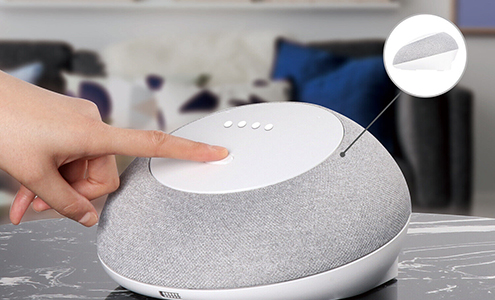In recent years, smart Bluetooth speakers with wireless communication, small size the overall sales the advantages of catching up or even catching up with the traditional active speakers, but the small size of the sound quality will certainly have a certain sacrifice, in addition to intelligent Bluetooth audio transmission process will also have a little impact on the sound quality, so basically the business propaganda"lossless sound quality"basic is nonsense.
Based on the above, we also detailed expansion into[Bluetooth, parameters]these two points to speak.

1, Transmission and Connection
Bluetooth audio and Bluetooth headset transmission method are similar, most of the Bluetooth audio will have to provide AUX audio input interface, which can be wired to connect the device. In addition to a wired connection, you can understand the Bluetooth transmission method, in the choice of Bluetooth audio can be more clear about their needs.
1. Bluetooth audio coding
Bluetooth audio is also the same audio coding, cell phones in the connection of audio work, will first rely on PCM audio signal quantization into a digital signal, according to the audio coding compression, and then transmit a specific frequency to the audio, the audio and then through the Bluetooth template to read the audio data and restore into an audio signal.
Different coding methods determine the coding efficiency and the amount of data transmitted, and audio coding will be backward compatible, for example, if the device is SBC, while the audio is AAC or aptX, the final will only be SBC.
Audio decoding determines the fidelity and the rate of some unimportant information. Different decoding protocols will all have different sound qualities.
2. Bluetooth module
Bluetooth module is mainly composed of PCB board, chip, and peripherals, but also used to receive frequency, read audio data and convert the main core of audio, determine the compatibility and stability.
There is relatively poor quality smart Bluetooth audio on the market will use a relatively poor Bluetooth template, which will also lead to unstable connection, including the inability to connect over long distances, but the general big manufacturers use chips that are basically close to CSR and other chips, so here it is not recommended to buy cheaper or unknown channels of audio, to avoid causing bad experience.
3. Bluetooth protocol
Bluetooth protocol is also the Bluetooth version, Bluetooth version actually does not affect the sound quality, mainly determined by the transmission speed, transmission distance, and transmission loss. Bluetooth audio on the market is 4.1.4.2.5.0.5.2.etc.
Bluetooth version and decoding protocol will be backward compatible, in the purchase, the audio does not need a very high Bluetooth version, so the Bluetooth version of 4.1 or more can choose.
4. WIFI transmission
For general intelligent voice audio, you need to connect WIFI, regardless of the sound quality, but a great degree of convenience in life, ecological connectivity, and the voice assistant is basically a big helper of intelligent furniture.
WIFI transmission does not need to rely on the device, through the WIFI connection, itself is an independent device, in terms of transmission compared to Bluetooth will be stronger, Bluetooth version 4.0 is almost 24Mbps, and WIFI can be described as a downgrade.
Most families can reach 100Mbps, in the transmission of the sound quality loss is smaller, basically is already equivalent to lossless sound quality.
That is not WIFI audio will be better than Bluetooth speakers, in fact, not, generally WIFI audio large to the volume, small to the unit, tuning can not be compared to Bluetooth audio, after all, WIFI audio is the pursuit of intelligence and portability, to meet the needs of the masses of intelligence.
2, Audio parameters
When we buy audio, we will see the following parameters, how to see it? For each parameter and means, there are some that need to pay attention to, I believe there will be a lot of first-time buyers of audio friends who will still be relatively dizzy, I will list the more important, ones in a more understandable way to explain.
1. Frequency response
Frequency response generally refers to the frequency response, and distortion is a very important parameter indicator;
Frequency response is more of a curve to represent the loud curve, which will change with the gain sound pressure frequency and the curve. The smaller the frequency response, the flatter and straighter the frequency response curve.
We know that the human ear can hear the frequency of 20~20000Hz, basically, audio as long as this frequency even if it is qualified, for the entire frequency range of the broad has exceeded human hearing, but is still able to listen to the sense of hearing. If the purchase of the business will give the frequency response curve, we only need to observe the 20~20000Hz section of the frequency is not too big ups and downs can be.
And the frequency response is important to also look at the three frequencies of the performance.
Low-frequency≈20-160Hz
Medium frequency≈160-2560Hz
High-frequency≈2560-20kHz
For example, the parameters are 70Hz~20kHz.
Can be interpreted as audio low-frequency performance 20Hz~70Hz can not be interpreted, in the low frequency can already be said to be passable, but the sense of shock is not enough, and to 20kHz is already to the location of the ultra-high frequency, although the ear can not hear such high audio, the body can also resonate with it and rich penetrating power.
2. Signal-to-noise ratio
The signal-to-noise ratio refers to the ratio of signal to noise in the system, expressed in dB, the higher the value of the signal-to-noise ratio, the smaller the noise, the better the sound quality.
For example on the parameter>80dB, that is, the output signal power is the noise power;10^8 times, and the output signal standard deviation is the noise standard deviation>10^4 times.
The general choice as long as it reaches 60+can be.
3. Distortion degree
Distortion and signal-to-noise ratio have a certain relationship, the difference between the two is that distortion is regular, while noise is irregular. Because the above chart parameters are not indicated, it is impossible to give examples. Distortion is generally expressed as a percentage, and the smaller the value, the smaller the distortion and the smoother the distortion.
Generally choose less than 5 percent can.
About the parameters, we only need to look at these 3 points, and as for the others basically do not care too much~these three points are enough for us to pick out a good sound.
3, The Hardware and Structure
Audio in addition to the above parameters to determine the sound of good or bad, we can also look at the hardware to decide. Audio by the speaker unit and the cabinet and the distributor as the basis of the combination, we also briefly understand, easy to refer to the purchase
The main role of the cabinet is to eliminate the acoustic short circuit of the speaker unit and inhibit its acoustic resonance, can play a wide range of frequency responses and further reduce distortion, the audio has a different structure and different materials will give off a different sound.
About the material
Most of the cabinet materials on the market are made of solid wood, there are also plastic, metal,and glass materials, four kinds of materials have their own characteristics~
Plastic audio because of the quality lighter, most portable audio, such as Bluetooth smart audio. Plastic material is also lighter because of the texture, and easy to produce resonance, in terms of sound quality advantages are poor.
Metal material in the market is relatively rare, and metal audio prices are also very high, the advantages of wooden material are better because the material density of MDF board is much higher, can reduce resonance generation, and the final presentation of the tone is also very unique.
Glass material is also a trend in recent years, the advantages of the material and metal are closer, and the appearance of more artistic, the price will be more expensive~glass itself is not low cost, it uses plexiglass, with better stability and resistance, so it is not easy to break because of the treble.
Wooden material most wooden audio using materials are MDF medium-density fiberboard block, it is plant fiber as raw materials, in addition to excellent physical properties, plasticity is also very good.
Material is only part of the impact on the sound quality but also depends on the size of the unit, the distributor, and the reasonableness of the cabinet.
About the structure
The structure of the sound can be broadly divided into closed and inverted;
Closed type: closed type is a common type of small audio, the box is relatively a sealed state, and the internal structure is relatively simple, closed box is equivalent to an air spring, so that the speaker vibration system strength, that is, the unit resonance frequency increases, the low frequency will be relatively high. And there is a better response and transient.
The disadvantage is that the sensitivity of the box is relatively low.
The external structure of the box increases a hole, and the substance is connected to a tube, in the work, the sound is issued by the internal formation of vibration and issued by the tube, the principle of close-to-the-tube music. The inverted phase of the unit is only its driving role, the real sound is the tube so that it can send a lower frequency and thus higher sensitivity.
You May Also Like:What is a smart Bluetooth speaker, and what are its uses










